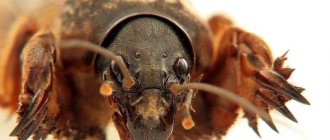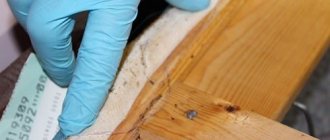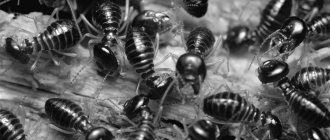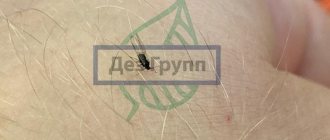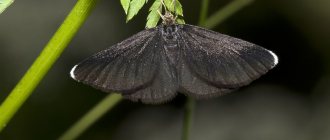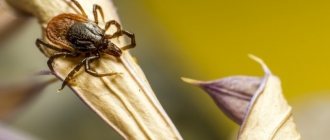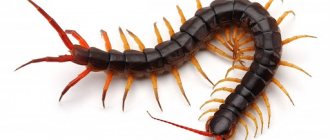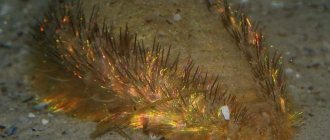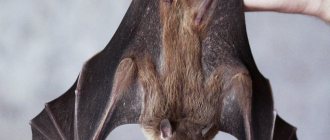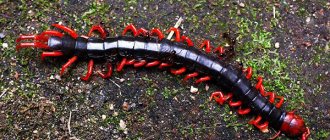Description and photo
These are medium sized mice. They are larger than the house mouse . Their body length is 7-10 cm , the tail is about the same length.
Her body weight ranges from 15 to 30 grams. The head is quite large in comparison with the body. She has a pointed muzzle with large eyes .
This type of mouse has very long ears , they can reach the eyes; with a body of 7-10 cm, the ears reach 2.2 cm.
The color is usually brown , but some individuals are yellow and even red. Young animals are dull in color, but over time their color becomes brighter.
Some individuals have a light spot on the chest. Such white spots are characteristic especially of individuals living in mountainous areas.
The peak behavior of wood mice is late evening, night and early morning . They do not hibernate in winter.
As mentioned above, there are many types of mice. You can find information about some of them on our website. Read all about the following: mole vole, yellow mole vole, steppe mole vole, voles: underground, dark, flat-skulled, narrow-skulled, Brazilian, red and red, housekeeper voles, gray vole and ground rat.
What do they eat
These are, first of all, seed eaters of trees such as oak, beech, ash, linden, hawthorn, and plane tree. They eat young plants, weeds, buds, and moss. If there are a lot of seeds on the ground, they carry them into burrows for storage.
May eat small invertebrates such as snails, slugs , insects, arthropods, earthworms, caterpillars, centipedes, especially in late spring and early summer when plants are not available.
In the fall, they eat berries, fruits, mushrooms, roots, sweet corn, wheat, oats, and blackberries. In winter they can hunt bats.
Distribution in Russia
In Russia, it is distributed everywhere, with the exception of the regions of the Far North and permafrost . The favorite habitats for this species are open forest areas.
The mixed forest in the river valley is an ideal place for the wood mouse to live.
They can make their nests in tree hollows, roots or dead wood. They often inhabit agrocenoses created by man, that is, gardens and fields, creating a complex system of burrows and passages underneath them.
Typically, such dwellings have several chambers for nesting and storing food supplies and 3-4 exits. In winter, they can move to warehouses and granaries in search of additional food supply and shelter from the cold, especially if the winter has been harsh.
Where do bats live?
If we talk about the territories where bats live, then we need to list the entire planet. The only exceptions are areas of tundra and land covered with ice. In these natural conditions, the life of bats is impossible. These animals are not found on some remote islands because they simply could not get there.
The bat is a rare mammal that can exist in almost any place where there is at least some opportunity for shelter during the day.
Representatives of this order can be found in all other corners of the globe. Even in large cities, in the attics of high-rise buildings, bats find shelter.
In nature, bats prefer to settle in caves, where, clinging to ledges, they sleep during the daytime, and at dusk they fly out to hunt. There are caves in which thousands of bat colonies live. Sometimes the height of the layer of excrement in them reaches a meter, which indicates the number of animals and the duration of their stay in this place.
Where there is no natural shelter, these animals are located in trees, hiding between the branches. Sometimes they occupy abandoned hollows, can build themselves shelters from large leaves, gnaw through bamboo trunks, and even settle between the fruits of plants. The main requirements for their house, where the bat sleeps all day, are safety and absence of direct sunlight.
These animals are not at all afraid of people, so they calmly settle in the attics of houses, barns, and livestock buildings.
Sometimes people, not knowing what bats eat in the wild, believe that they can be dangerous to humans and domestic animals. Therefore, when they find these animals in their attic or barn, they try to exterminate them. Most bats eat insects and are therefore absolutely safe.
What does it eat, where is it included in the food chain?
REFERENCE: There are known cases where mice completely destroyed the seeds of beech, maple and linden in forestry. They can also destroy sown and sprouted seeds of agricultural crops on a large scale.
This is what the wood mouse eats in the forest - these are the seeds of deciduous trees .
In second place in preference are berries and small insects , but they rarely eat green foliage, only if they are very hungry. This usually happens in the spring, when there is an abundance of fresh greens, but there are no seeds and berries yet.
Since this species of mouse is known to be active all year round, this makes them easy prey for predators.
Their numbers are regulated by owls, ferrets and weasels . In winter, foxes can also enjoy them.
IMPORTANT: Despite the significant damage they cause to green spaces, hedgehogs, snakes and birds of prey could not survive without wood mice. For the latter, this is especially important in winter.
Relations within the colony
Wood mice live in numerous colonies, but each individual is assigned a certain area - about 5 sq.m. The head of the family is the male. Quarrels constantly break out between young males over the right to own a female and on other issues.
The colony has several dominant females who help raise young offspring. Often several females give birth to cubs in one nest, feed them together, and teach them life.
Interesting!
Cannibalism is not common among mice, but weak cubs can be eaten by the female to enable stronger individuals to receive more nutrition. If the father of the family gets into the nest, he can devour everyone indiscriminately.
What harm causes and methods of control
The wood mouse adapts very easily to various biological conditions and can colonize fields with grain crops.
They cause enormous damage to farms , destroying winter and spring crops of cultural and industrial plants over large areas, primarily rye, oats and wheat.
REFERENCE: As calculations have shown, if at the end of spring 6 pairs of mice live on arable land, then by the end of autumn, under favorable conditions for rodents, their number can reach 7-8 thousand.
They spoil agricultural crops at all stages of plant growth: they eat sown grain in the ground, gnaw out young shoots, and spoil the stems and leaves of plants.
But most of all, ripe grains of cultivated crops are destroyed. One wood mouse eats an amount of grain equal to its own weight per day.
By digging holes in the ground, they damage the root system of plants . In gardens and nurseries, mice gnaw out trunks, shoots and roots of fruit trees and shrubs, spoil and destroy ovaries, and eat ripe berries and fruits .
The problem is also that these rodents are able to spread and reproduce over a vast area of cropland in a short period of time.
Mice build a complex system of burrows with a large number of passages and several storage facilities in which they store grains of oats, wheat, rye and barley for the winter.
IMPORTANT! Wood mice are carriers of dangerous diseases such as hemorrhagic fever and leptospirosis. Fleas carried by mice can pose a very serious threat to pets.
Methods of controlling wood mice can be divided into two methods: preventive measures and direct destruction.
Preventive measures include installing various repellers and building protective barriers .
In small farms, this means laying out plants whose smell repels rodents: garlic and black root, and installing mechanical and electronic repellers.
To kill mice in a small area, their holes are filled with a special repellent solution .
But in the event of a mass invasion of rodents, radical measures must be taken. Destroying a mouse population is not an easy task; it requires an integrated approach.
For large farms with huge cultivated areas, it is necessary to contact special companies and organizations that carry out mass deratization .
Main methods of deratization:
- installation of ultrasonic repellers;
- installation of mousetraps with bait;
- glue-based traps;
- scattering of poisoned grain;
- pollination of centers of mass settlement of mice with pesticides.
To effectively exterminate rodents, all mice control measures must be used. Compliance with safety measures is also of great importance : measures to destroy mice should not harm the soil or human health.
IMPORTANT! Mice pose a major threat to harvested crops. Making their way to places where crops are stored, to warehouses with grain and flour, they destroy reserves, eating them and polluting them with waste from their vital activity.
Not only mice can cause significant damage to garden plots and vegetable gardens. We bring to your attention a series of materials about wild rats, shrews, bats, and moles. And also about insect pests: potato moths, bedbugs, Colorado beetles, chafers, mole crickets, ants, nematodes, spider mites, moths, locusts, slugs, armyworms, aphids, thrips and cicadas.
Animal mouse - everything about these rodents
The mouse is an animal known to mankind for hundreds of years. During this time, the animal went from a pest to a pet and an indispensable assistant for doctors. Even small children know what a mouse looks like.
Destruction Bitten, what to do How long do they live? Squeaks in the walls How to kill How to distinguish from a rat How to remove them from a cellar Protecting grapes in winter How to remove them from a car How to remove them from a garage How to fight Do they live in mineral wool Do they eat polystyrene Anatomy and physiology What kind of remedies are there What smells do they not like Traps Bait in a mousetrap Reproduction and childbirth Varieties What are they afraid of What do they eat at home How to protect apple trees in winter What diseases do Gnaws carry? ut polyurethane foam BlackrootKak catch without a mousetrapGluePoisonUltrasonic repellerHow to get rid of in the apartmentHow to get rid of in the houseBrownieVoleSeaJapaneseBlackLaboratorySpinousWith stripeThe largest ShrewForestBabyWhiteGerbilsDecorative
A mouse is an animal or mammal belonging to the rodent order. They are distributed all over the world. The sizes of the animals are small - from 4 to 12.5 cm. They are nocturnal. The mouse is a herbivorous rodent, only some dilute their diet with meat.
A living mouse is the causative agent of many diseases and harms the farm. Despite the fact that a mouse is a beast or animal that causes a lot of problems for people, these rodents will bring a lot of positive emotions as a pet. You can read about keeping mice in articles
It doesn’t matter where the mouse lives - in a cage or a plastic container, it will be a favorite of the whole family
We are in social networks
Survey
VetUgolok.ru 2015 - 2022. All rights reserved.
Traces of life activity
Often, even without seeing a rodent, you can determine its species by carefully examining the room in which the animal lived:
- Mice move in small mincing steps, leaving small tracks up to 1 cm long. The fingers in the footprint are located close to each other. Rat tracks are larger, the toes are widely spaced, the angle between the outer phalanges is about 180°. Rats move over long distances by jumping, so there can be a significant gap between tracks.
- The damage left by rodents also varies. Mice can chew through plastic bags, cardboard and foam boxes in search of food. The rat needs regular grinding of its rather large incisors, so it chews on tougher things and can cope with hard wood and even concrete.
- In rooms where rats visit, you can see traces of fur near the baseboards. This is due to the fact that pasyuks move pressed against the wall. Mice are more reckless and run straight to the goal.
- Rat excrement is 1 to 2 cm long, located in a heap. Mouse - small, up to 6 mm, scattered throughout the room.
